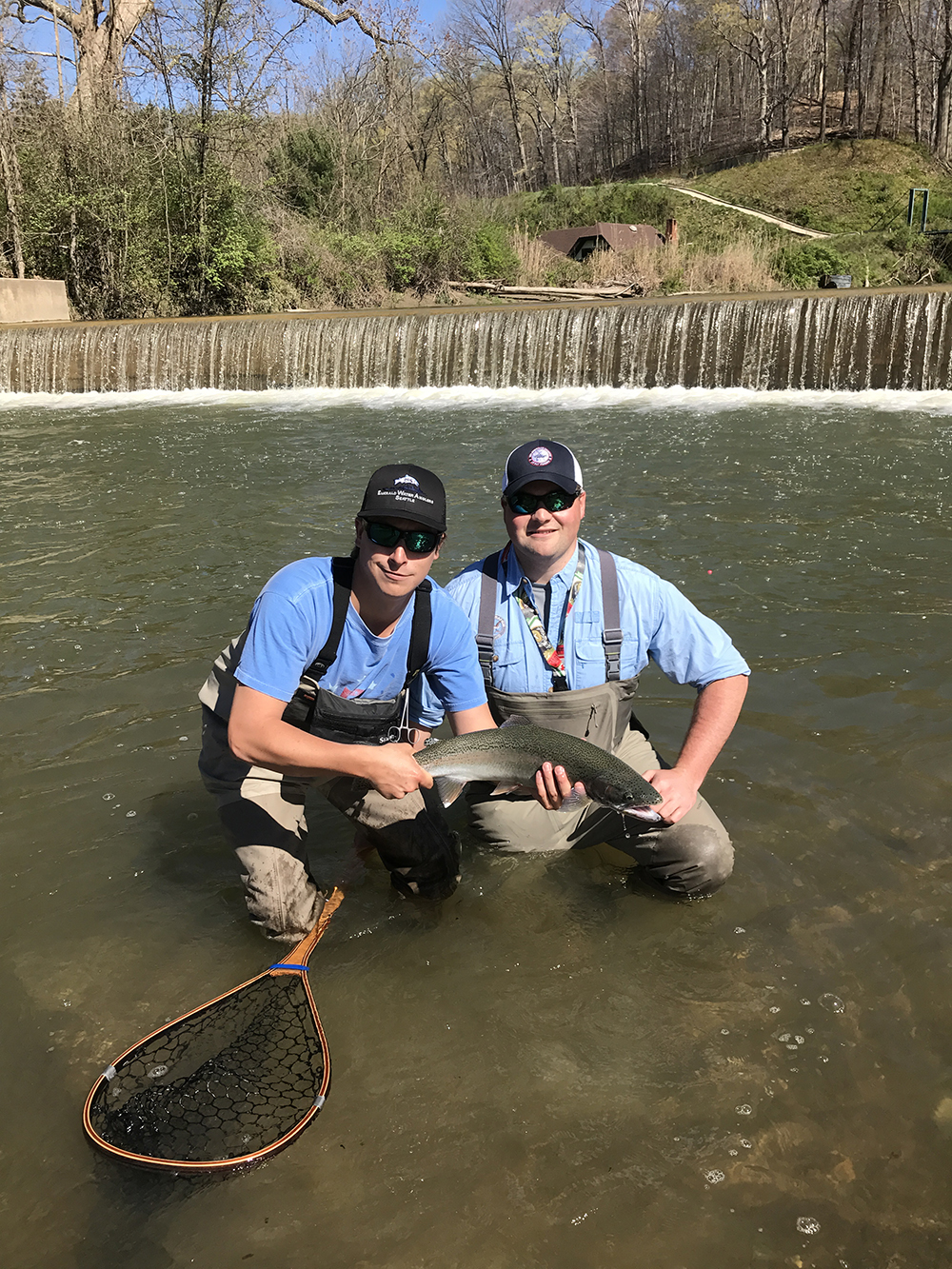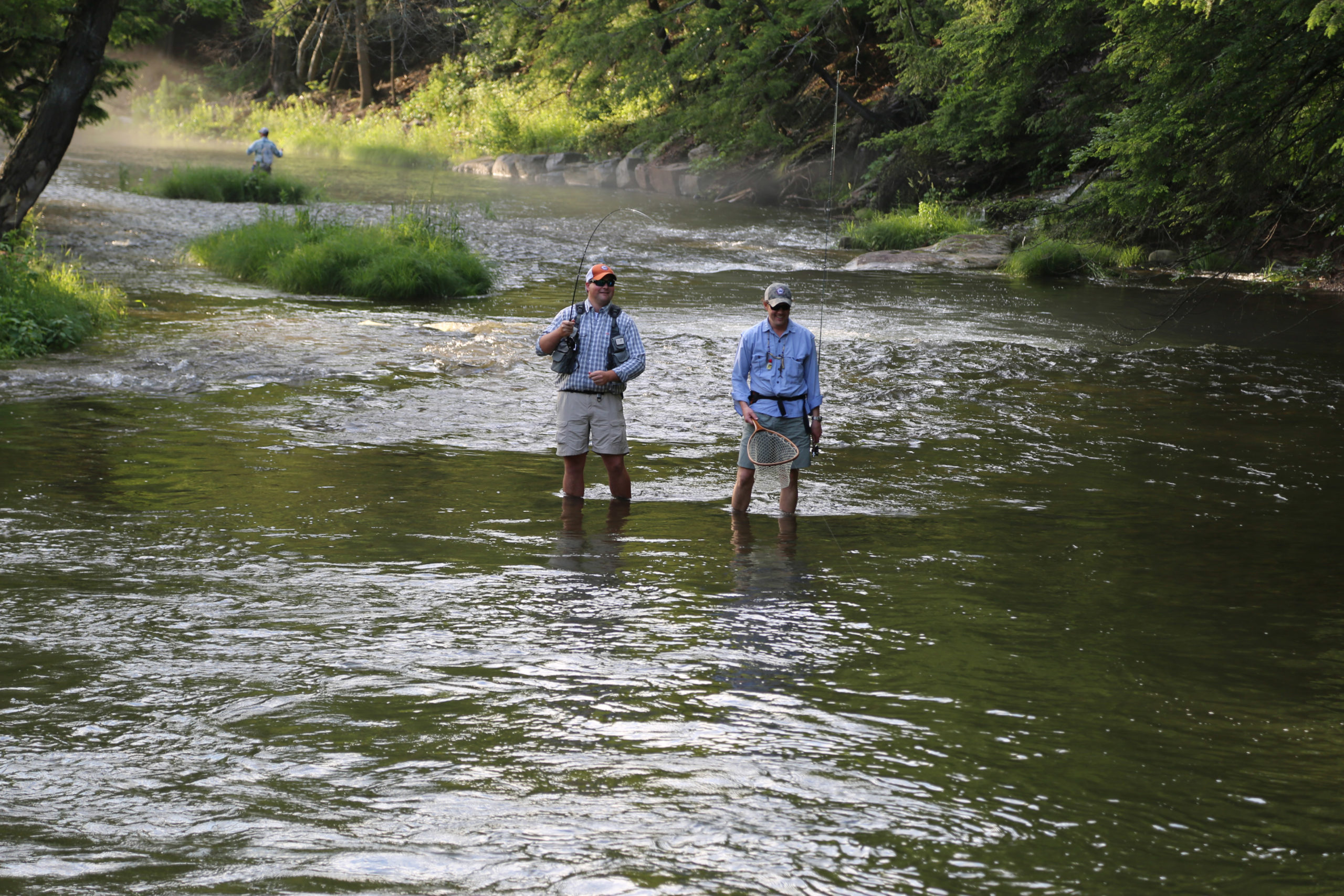Woods King IV is an avid angler and co-chair of the Angler’s Circle. He grew up in a fishing household learning from his father. One might not think of Cleveland, Ohio as a fly fishing destination, but we’ll let Woods change your mind on that one…
Tell us about your very first catch.
The first fish I remember catching was a bluegill in my grandparents’ pond. I remember at a very young age fishing with my dad on summer afternoons. When I was too young to cast, my dad would cast and hook the fish, and I would reel it in.
Who or what got you started in fly fishing? Why fly fishing?
My father was the one who introduced me to fly fishing. Previous generations of family members and great family friends were avid anglers – it has been contagious. Between the friendships that develop while on the river, the connection to the outdoors, and tradition associated with the sport and lifestyle, it is difficult to drift away.

Woods King IV (right, in AMFF trucker hat) guides a friend onto a steelhead on the Chagrin River in Ohio.
Where is your favorite place to fish? What makes it so special? Don’t worry, we’re not giving up the secret spots.
Growing up in Cleveland, Ohio, It is hard not to identify one of my favorite places to fish as the Chagrin River for Great Lakes steelhead trout. This fishery began about 20 years ago and has taken off. Battling six to twelve-pound fish during the fall and spring runs fifteen minutes from home is hard to beat.
New Brunswick Canada on the Upsalquitch will always have a special place in my heart because of the family connection and first fly fishing trips for Atlantic salmon.
Star Valley, Wyoming has become a favorite destination of mine in the last ten years, as well. I have been fortunate enough to take annual trips in the fall for the last few years fishing for wild brown, brook, and cutthroat trout.
Tell me more about the fly fishing culture in Ohio. One might overlook Cleveland as a hub for the sport but the attendance at the Fly Fishing Film Tour says otherwise.
Yes! The Fly Fishing Film Tour comes to Cleveland each March and you would be hard pressed to find another venue with as much enthusiasm from the crowd. We sell out the theater at the Cleveland Museum of Natural History each year and proceeds benefit their trout club, which I am a member of.
Steelhead fishing is a huge part of the fishing culture here. The runs in the Spring are the stuff of legend and, while it’s not as good, they run here in the Fall as well. There is an avid group of fly fisherman here who get up at ridiculous times each morning in search of steel.
Right now there is a great small mouth bass run out of Lake Erie. There are many ponds and lakes that folks fish for bass, crappy, blue gill, etc.
There is a great history of fly fishermen here, many used to travel all around the world (and still do) before steelhead became popular fifteen to twenty years ago.
What was your best day fishing or what do you consider to be a great day on the water?
It is difficult to narrow this down to one specific day, but after racking my brain, I would have to say there are two days that stick out from the rest:
Fishing the Brooks River on the Alaska Peninsula with my grandfather, Peter Bergsten, will always be a highlight. All aspects of the day were incredible – countless wildlife sightings, avoiding the brown bears, the family connection, and, above all, the fact that any time my fly touched the water, it hooked a large wild rainbow trout.
Fishing the Upsalquitch River with my father, Woods King III, was an experience I will treasure. I was lucky enough at a young age to go on my first trip to New Brunswick and be able to repeat the trip for nearly a decade. One day in particular stands out. I remember landing a twelve-pound salmon on a “bomber”. This memory stands at the forefront of the time experienced at MacLennan Lodge.
Everyone has the “one that got away”. Some have many. Tell us about yours.
I try to forget about these situations as soon as they happen, but the most recent lost-lunker was a cutthroat trout at The Meadows in Star Valley, Wyoming. I won’t get into details, but the situation was all the more heart-breaking because advice was given, I didn’t take it, and lost the fish in the presence of a witness.
I think the most disheartening experience fly fishing was on a camping trip to Penns Creek, PA. I was on dish duty after dinner and got turned around in the dark on the way the creek. After lugging a Dutch oven and utensils around in the woods for a few hours, I made the decision to find a dry spot and wait out the night. Right about the time I reluctantly huddled against a tree, a friend found me and we made our way back to the tents. Waking up the next morning with a sore arm, a bad case of poison ivy, and a severely bruised ego, I realized a valuable lesson – always carry a compass and know your surroundings.

Woods King IV plays a fish while Parker Corbin mans the net during a recent Anglers’ Circle outing at the Tuscarora Club.
Why did you join the Anglers’ Circle?
I was introduced to the American Museum of Fly Fishing at a young age. As I was completing college and graduate school, I was introduced to Parker Corbin and several others who were creating what was then called the Junior Committee. After a year of evolution and growth, the Anglers’ Circle was born. It was great to get involved on the ground floor and continue to grow the AC. I felt it was a great opportunity to get involved with the AMFF and help the Museum broaden its reach across the country with the younger generation.
What advice would you give to a person thinking about joining the AC?
I would advise anyone who is interested to get involved and take advantage of the great opportunities the AC and AMFF provide. It is thought-provoking to learn about the history of the sport of fly fishing, but in addition to those opportunities, which are frequent and always at your fingertips with the enhanced digital platforms, there are trips and networking opportunities that are usually out of reach, especially for those of us under thirty years old.
What does fly fishing history and the AMFF mean to you?
It has been significant to learn how fish were caught by anglers over the past hundred years. Being able to see, touch, and use some of the equipment from that time period brings a lot into perspective. Reviewing the evolution of tactics and technology and seeing how they play a role in the transitions we have seen over the years has hit home for me. Being able to see these artifacts, art, writings in person or digitally, connects anglers on a deeper level than by just catching fish.
The AMFF, in the role of storyteller, is able to connect the history of the sport with current fishermen and women, the fly fishing industry, as well as conservation groups, and future anglers.
Learn more about the Anglers’ Circle program by contacting pnardini@amff.org or clicking the link below to join.

